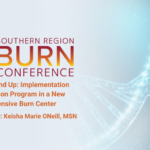Abstract | December 20, 2021
From the Ground Up: Implementation of an Education Program in a New Comprehensive Burn Center
Learning Objectives
- Identify the 2 teaching methods implemented in the new comprehensive burn center.
- Identify the learning model used to develop the education curriculum in the new burn center.
- Discuss the outcomes of the education curriculum implemented in the new burn center.
Introduction:
A large academic hospital with a pediatric burn program recently expanded its services to take adults and create a comprehensive burn center. Prior to the opening of the comprehensive center, proactive training and education for all the nursing staff was designed and implemented, in amalgamation with an existing pediatric education program. The burn program ultimately opened during the pandemic, in the back drop of nursing shortages and turnover- further necessitating a solid educational curriculum. This study describes and evaluates the efficacy of a novel burn nursing education program based on the American Burn Association’s nursing competencies.
Methods:
Kolb’s Experiential Learning Model was used to develop and outline the process for burn nursing education. Educational offerings were mixed didactic and simulation based. Didactic content included wound care and evaluation, chemical and electrical burns, airway and surgical management, rehabilitation and fluid resuscitation while simulation was utilized for wound care and wound care products and rehab. The didactic portion of the education was evaluated using a pretest-posttest design. Whereas, the simulation portion of the education was evaluated using verification in practice. A wound care/dressing check off sheet with a pass or fail scoring process was designed using the institutional wound care guidelines. The aim of the wound care check-off, or verification in practice, was to have the nurse perform wound care both competently and independently. The check-off process was performed, both at the bedside and in simulation, by the nurse expert practitioner and the burn program manager. Nurses also evaluated the overall course on a 1-5 Likert scale. Pre and posttest scores were compared using a T-test, with a p-value of <0.05 considered significant.
Results:
A total of 202 registered nurses, both pediatric and adult, have successfully completed a written exam and been validated in practice for the simulation portion of their education. Average test scores form the didactic portion showed a statically significant Course evaluations were returned by 46 nurses (56%). Evaluations of the program indicated a mean of 4.5 /5 for efficacy of the program and 4.7/5 for speaker knowledge. The overall comments indicated the courses were very helpful and the nurses felt more confident in burn care after attending them.
Conclusion:
The burn nursing education program resulted in significantly higher post-test scores, reflecting an increase in burn knowledge. Upon review of the course evaluations, the program was rated as extremely effective by the participants. Nurses indicated they felt more confident and prepared to provide burn care. The participants requested more simulation versus didactic education for future planning. In response to their feedback, the current education model will transition to a hybrid model, with online education for the didactic sessions and enhanced simulation for FY 2022. As nurse recruiting continues, ongoing burn education will be necessary to provide a comprehensive orientation process that will lead to high quality patient care. All burn nurses will be required to complete an annual burn competency modeled from the ABA burn nursing competency initiative.

